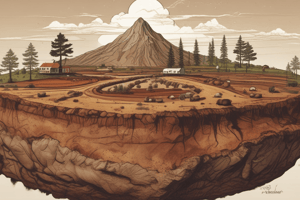Podcast
Questions and Answers
What primarily binds the basic layers of illite together?
What primarily binds the basic layers of illite together?
- Magnesium ions
- Hydrogen bonds
- Potassium ions (correct)
- Calcium ions
What role does soil play in carbon and nutrient cycling?
What role does soil play in carbon and nutrient cycling?
- Soil provides a habitat for plants only.
- Soil facilitates the transfer of nutrients between organisms. (correct)
- Soil prevents the decomposition of organic matter.
- Soil prevents water from reaching roots.
Which property distinguishes montmorillonite from illite?
Which property distinguishes montmorillonite from illite?
- Absence of octahedral sheets
- More stable under heat exposure
- Containment of water molecules between layers (correct)
- Higher strength due to stronger bonds
Which of the following is NOT a function of soil?
Which of the following is NOT a function of soil?
How many sheets of silica tetrahedron are sandwiched in the basic layer of montmorillonite?
How many sheets of silica tetrahedron are sandwiched in the basic layer of montmorillonite?
How does soil contribute to agriculture and forestry?
How does soil contribute to agriculture and forestry?
What is one reason why humans could not survive without soil?
What is one reason why humans could not survive without soil?
What type of bonding is primarily present in the basic layer of montmorillonite?
What type of bonding is primarily present in the basic layer of montmorillonite?
What is the structural composition of the basic layer of illite?
What is the structural composition of the basic layer of illite?
Which statement about the composition of soil is accurate?
Which statement about the composition of soil is accurate?
What is the result of the reaction between kaolinite and water in the presence of hydronium ions?
What is the result of the reaction between kaolinite and water in the presence of hydronium ions?
What is the significance of high rainfall in tropical regions concerning soil composition?
What is the significance of high rainfall in tropical regions concerning soil composition?
Which of the following best describes the process of complexation in soil weathering?
Which of the following best describes the process of complexation in soil weathering?
What occurs as primary minerals undergo oxidation when exposed to the atmosphere?
What occurs as primary minerals undergo oxidation when exposed to the atmosphere?
Which clay mineral is produced as a result of the oxidation of biotite?
Which clay mineral is produced as a result of the oxidation of biotite?
What types of minerals are produced as a result of the weathering sequence involving aluminosilicates?
What types of minerals are produced as a result of the weathering sequence involving aluminosilicates?
What is the primary solubility concentration of silicic acid in tropical soils?
What is the primary solubility concentration of silicic acid in tropical soils?
What role do organic acids play in soil chemistry during weathering?
What role do organic acids play in soil chemistry during weathering?
What is the median size of the particles in the first mode?
What is the median size of the particles in the first mode?
What percentage of particles is found in the second mode?
What percentage of particles is found in the second mode?
Using the soil texture triangle, how is the soil texture classified?
Using the soil texture triangle, how is the soil texture classified?
What percentage of the particles does the third mode contain?
What percentage of the particles does the third mode contain?
Which mode accounts for 30% of the particles?
Which mode accounts for 30% of the particles?
According to the interpretation rules, what classification is given when a soil texture point lies on the boundary line between two classes?
According to the interpretation rules, what classification is given when a soil texture point lies on the boundary line between two classes?
If a soil texture point lies between sandy loam and clay, what classification applies?
If a soil texture point lies between sandy loam and clay, what classification applies?
What results from isomorphous substitution of Al3+ for Si4+ in clay?
What results from isomorphous substitution of Al3+ for Si4+ in clay?
Which cations are mentioned as contributors to charge compensation in clay?
Which cations are mentioned as contributors to charge compensation in clay?
What does isomorphous substitution refer to in the context of clay minerals?
What does isomorphous substitution refer to in the context of clay minerals?
Where is the negative residual charge located in clay minerals?
Where is the negative residual charge located in clay minerals?
What characteristic of cations in the interlayer space of clay is described?
What characteristic of cations in the interlayer space of clay is described?
Which of the following statements is incorrect regarding clay minerals?
Which of the following statements is incorrect regarding clay minerals?
What is a key consequence of the negative charge in clay soils?
What is a key consequence of the negative charge in clay soils?
The crystal form of clay remains unchanged during isomorphous substitution. What term describes this feature?
The crystal form of clay remains unchanged during isomorphous substitution. What term describes this feature?
What is the primary factor that contributes to a soil's permeability?
What is the primary factor that contributes to a soil's permeability?
What could be a consequence of low permeability in soil?
What could be a consequence of low permeability in soil?
Can soil with low permeability still have high porosity?
Can soil with low permeability still have high porosity?
Which element has the highest concentration in soil based on total elements measured?
Which element has the highest concentration in soil based on total elements measured?
What is the role of clay minerals and organic matter in soil?
What is the role of clay minerals and organic matter in soil?
What can low permeability cause in soil after heavy rainfall?
What can low permeability cause in soil after heavy rainfall?
Which of the following cations is known to be adsorbed by clay in soil?
Which of the following cations is known to be adsorbed by clay in soil?
Which chemical property of soil is crucial for nutrient retention?
Which chemical property of soil is crucial for nutrient retention?
Flashcards
Illite basic layer structure
Illite basic layer structure
An aluminum octahedron sheet sandwiched between two silica tetrahedron sheets, weakly bonded by potassium ions.
Montmorillonite basic layer structure
Montmorillonite basic layer structure
Similar to illite, with an aluminum octahedron sheet between two silica tetrahedron sheets, held together loosely by water molecules.
Hydrogen bonding in clay layers
Hydrogen bonding in clay layers
A strong force that holds the basic clay layers together.
Exchangeable cation in illite
Exchangeable cation in illite
Signup and view all the flashcards
Montmorillonite swelling/shrinkage
Montmorillonite swelling/shrinkage
Signup and view all the flashcards
Soil's role
Soil's role
Signup and view all the flashcards
Soil composition
Soil composition
Signup and view all the flashcards
Importance of soil
Importance of soil
Signup and view all the flashcards
Soil functions
Soil functions
Signup and view all the flashcards
Soil organisms
Soil organisms
Signup and view all the flashcards
Soil Texture
Soil Texture
Signup and view all the flashcards
Soil Texture Triangle
Soil Texture Triangle
Signup and view all the flashcards
Median Size
Median Size
Signup and view all the flashcards
Soil Mode
Soil Mode
Signup and view all the flashcards
Sandy Clay Loam
Sandy Clay Loam
Signup and view all the flashcards
Determining Soil Texture
Determining Soil Texture
Signup and view all the flashcards
Two-Class Line
Two-Class Line
Signup and view all the flashcards
Soil Texture Interpretation
Soil Texture Interpretation
Signup and view all the flashcards
Weathering of Feldspar
Weathering of Feldspar
Signup and view all the flashcards
Kaolinite Formation
Kaolinite Formation
Signup and view all the flashcards
Silicic Acid and Red Soils
Silicic Acid and Red Soils
Signup and view all the flashcards
Complexation in Weathering
Complexation in Weathering
Signup and view all the flashcards
Organic Complexes and Soil
Organic Complexes and Soil
Signup and view all the flashcards
Redox Reactions in Weathering
Redox Reactions in Weathering
Signup and view all the flashcards
Biotite Weathering
Biotite Weathering
Signup and view all the flashcards
Secondary Minerals and Weathering
Secondary Minerals and Weathering
Signup and view all the flashcards
Isomorphous substitution
Isomorphous substitution
Signup and view all the flashcards
Negative charge in clay
Negative charge in clay
Signup and view all the flashcards
Cations in interlayer space
Cations in interlayer space
Signup and view all the flashcards
Exchangeable cations
Exchangeable cations
Signup and view all the flashcards
What makes clay sticky?
What makes clay sticky?
Signup and view all the flashcards
Clay's role in soil
Clay's role in soil
Signup and view all the flashcards
How does isomorphous substitution affect soil?
How does isomorphous substitution affect soil?
Signup and view all the flashcards
What makes different clay types unique?
What makes different clay types unique?
Signup and view all the flashcards
Permeability
Permeability
Signup and view all the flashcards
High Permeability
High Permeability
Signup and view all the flashcards
Low Permeability
Low Permeability
Signup and view all the flashcards
Porosity
Porosity
Signup and view all the flashcards
Anaerobic Conditions
Anaerobic Conditions
Signup and view all the flashcards
Cation Exchange Capacity (CEC)
Cation Exchange Capacity (CEC)
Signup and view all the flashcards
Soil Chemical Properties
Soil Chemical Properties
Signup and view all the flashcards
Total Elements
Total Elements
Signup and view all the flashcards
Study Notes
Environmental Chemistry - Lecture 10: Soil Chemistry
- Course: CHEMISTRY 321, Fall 2024
- Instructor: Maryam Izadifard
- University: University of Calgary
- Lecture 10 focuses on Soil Chemistry
Part I: Introduction
- Suggested Readings:
- Manahan chapters 9.1-9.3 and 10
- CB/MC 4th or 5th edition: Chapter 16
- GW Van Loon and SJ Duffy "Environmental Chemistry" 3rd ed. Chapters 14, 17-18
- YouTube video link provided
Objectives
- Describe the composition of soil
- Understand that soil is a 3-phase mixture
- Recognize kaolinite, montmorillonite, and illite (differences)
- Classify soil by physical properties (particle size, texture, permeability)
- Use the soil texture triangle to determine soil texture
- Understand the pathways of rock transformations to soil (physical, chemical, and biological weathering)
- Recognize components of soil organic matter
- Define chemical properties (organic matter, pH, available elements, cation exchange capacity)
- Understand that colloids have a large specific surface area and cation exchange capacity
- Define total and available elements, cation exchange capacity, and base saturation
Why Soil is Cheap
- Soil remains abundant in many areas, making collection/sale inexpensive
- The market undervalues soil's ecological importance and long-term effects of degradation
- Soil is often treated as surplus or waste from industries like construction
Terrestrial Environment
- Terrestrial environments cover 29% of Earth's surface area
- The land is primarily composed of rocks and soil—the geosphere—which comprises the outer 40 km of Earth's crust
- Environmental chemistry of terrestrial ecosystems focuses on the study of soils
Why Study Soil?
- Soil is the link between air, water, rocks, and organisms
- Soil is responsible for many crucial functions (carbon and nutrient cycling, agriculture, forestry, water cycling, natural waste decomposition)
- Soil provides habitats for microorganisms, insects, etc.
What is Soil?
- Soil is a product of weathering—physical, chemical, and biological processes—of rocks.
- It's a medium conducive to plant growth.
- Soil has four fundamental components: finely divided mineral matter, various levels of organic matter, water, and air (gas phase).
- Soil is a three-phase mixture: solid, liquid, and gas
Soil Profile: Vertical Layering of Soil Horizons
- Soil has distinct horizontal layers, or horizons, with varying characteristics
- Each layer, or horizon, has a specific name.
Weathering by Rainwater
- Rainwater percolating through soil transports soluble and colloidal materials downwards
- This process creates banded layers known as horizons
Silicate Minerals in Soil
- Table showing the most common elements in soil (ppm)
Four Major Components of Soil
- Finely divided mineral matter (primary and secondary)
- Various levels of organic matter (1-6%)
- Water (liquid phase)
- Air/Gas phase
Why Clays are Important?
- Clay particles are smaller than sand and silt, creating a vast surface area.
- This large surface area is crucial for various soil processes
The Soil Particle Size
- Classification system for soil particles (clay, silt, sand, gravel)
Clays
- Aluminosilicates
- Important minerals
- Natural water barriers
- Constituent of soils
- Sheet-like structures (illite, kaolinite, montmorillonite)
Clay Minerals
- Detailed chemical structures of kaolinite, illite, and montmorillonite
Model Diagram of Montmorillonite Clay Structure
- Illustrates the structure of montmorillonite clay
Additional Clay Mineral Information
- Descriptions of kaolinite, illite, and montmorillonite crystal structures
Weathering by Hydration, Acid-Base Reaction, and Hydrolysis
- Chemical processes leading to soil formation from rocks by adding water, reactions with carbonic acid, and reactions with water
Weathering by Complexation and Redox Chemistry
- Processes of chemical weathering involving complexation with organic molecules and oxidation/reduction reactions
Biological Weathering
- Role of living organisms in soil formation (trees, microbes, animals/insects)
Soil Properties: Physical Properties
- Size: Particle size classification (clay, silt, fine, coarse, gravel)
- Texture: Combining percentages of clay, silt, and sand
- Permeability: Ability to conduct water
Soil Properties: Chemical Properties
- Total elements: Abundance in soil (table provided)
- Organic matter: Sources and role in soil function
- Available elements: Essential elements in useable forms for plants
- CEC (Cation exchange capacity): Capacity to retain nutrients, and their measurement
Example 2: Finding CEC in Soil
- A practical example illustrating how to calculate CEC
Soil Organic Matter
- Describing Humus, humic acids, and fulvic acids, their functions in soil
Soil Chemical Properties: Available Elements
- How plant availability of elements is measured in soil.
Clay and Humic Materials
- Colloidal materials, surface properties, electrostatic attraction, importance for nutrients and pollutants
Large Surface Area
- Explanation of surface area calculation
Negative Charge
- Discussion of how clays and humic materials develop negative charges
Soil Chemical Properties: Soil pH
- Dependence on soil composition, carbonate minerals, humic materials, and redox
Part II: Environmental Issues Associated with Soils
- Issues addressed: Soil erosion, too little/much water, nutrient leaching, acidification, salinity, metal contamination
- Further readings in related chapters
Objectives
- Awareness of environmental issues associated with soil
- Addressing questions related to the issues
- Definition and plotting stages of soil buffering
Studying That Suits You
Use AI to generate personalized quizzes and flashcards to suit your learning preferences.




